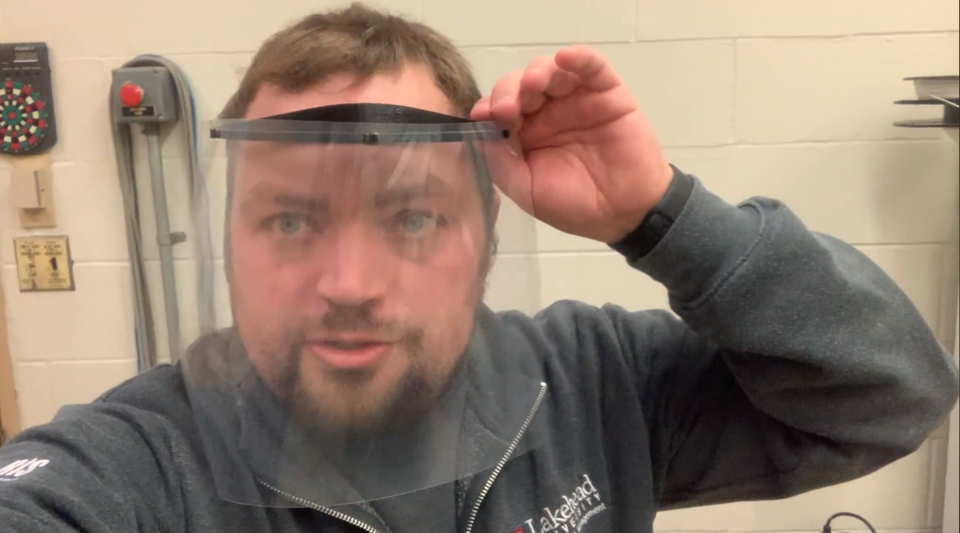An impromptu cottage industry has sprung up in Thunder Bay to help front-line workers shield themselves from COVID-19.
Lakehead University’s Alex Bilyk put out a rallying cry this week to encourage people with access to 3D printers to start making face shields and mask straps for local health-care workers.
“The need is huge,” said Bilyk, the manager of the Centre for the Application of Resources Information Systems (LU-CARIS).
“We’re getting a ton of ask.”
Bilyk would normally be in his lab designing and teaching about the applications of unmanned aerial vehicles, or drones, in natural resources management.
But he was spurred to action by the daily experiences of his wife, an emergency room nurse at Thunder Bay Health Sciences Centre, the major regional hospital for all of northwestern Ontario.
“I get to hear the other side of things, too. When I hear there’s a shortage of PPE (personal protective equipment), then that has a personal connection.”
Doctors at the local hospital go through about 20 face shields a day for surgery and intubations related to potential COVID cases.
“The sources for them are drying up so they’re looking for long-term solutions,” said Bilyk.
He began printing the shields after going online to various open source websites like Stratasys and Thingiverse where files can be downloaded on all kinds of things to 3D print.
The sites have worldwide databases of items that have been tested by the U.S. National Institute of Health.
To draw attention to the situation, Bilyk put out a call to action on an April 5 Facebook video posting.
He was taken aback by the reaction from local physicians, pharmacists, grocery store workers and police officers; the latter want the shields to protect themselves from people spitting on them.
“It’s been pretty incredible. I think we cracked 10,000 views on the first two days.
“We’re a small lab posting niche stuff about drones and underwater rovers. So we don’t normally get that kind of exposure with our videos.”
Want to read more stories about business in the North? Subscribe to our newsletter.
Now CARIS is one of a number of student-run labs on the now-closed campus that are coordinating their efforts to make the shields and distribute them for free.
Those on board include Lakehead University’s Engineering Makerspace, the library, and a student group at the Northern Ontario School of Medicine.
“We’re all working together to come up with common designs that we can then start ramping up production,” he said.
On his lab’s 3D printer, Bilyk is producing a three-piece unit – face shield and visor with an elastic band fastener – every hour and 10 minutes, around the clock.
What the exact need is in the community by front-line and health-care workers is still being determined, but they’re disappearing as fast as Bilyk is making them.
“I’m sitting here looking at a pile of 30 since last night,” he said. “As we make them, they’re going out the door.”
He boxes and leaves the masks in a shopping bag hanging on the door of his house for pickup.
Shortly, they hope to have a formal distribution program set up.
A newly launched local website, Covidtbay.ca, points directly to a Facebook group to better coordinate all the makers in town with 3D printers to have access to the same files and to answer common questions.
Bilyk is using a grade of plastic in his masks for workers in relatively lower risk environments, while the Lakehead engineering team is manufacturing masks with PETG (polyethylene terephthalate) plastic, normally used in food, beverage and liquid containers.
PETG is more germ- and chemical-resistant and is durable enough to be sanitized multiple times for use in sterile environments, like an operating room or intensive care unit.
“They’re also laser-cutting face shields to make a longer mask than we’re able to do. It’s all about the environment you’re operating within,” Bilyk said.
While LU-CARIS is completely self-funded to make these shields – the lab generates revenue from the drone, GIS and remote-sensing training they offer to industry – other student groups are not so lucky and will be out of pocket.
A GoFundMe campaign has been set up to help them with production costs. From the community-at-large, Bilyk has been amazed by the overtures to assist.
“There are a ton of these basement makers in town doing this. We’ve had people reach out to ask, what if I bought a 3D printer?
“It’s kind of neat to see what happens in the North when everyone pulls together to ask, how can I help?”
In thinking about how the pandemic will reshape and retool the country’s manufacturing and innovation capacity, he draws parallels with the financial crisis of a decade ago.
“It just shows the ingenuity. Some of the biggest companies that are influencers today came out of the 2008 crash. I think you’re going to see those pivots happening in business here or people that get that entrepreneurial bug and say, maybe we should be producing this kind of stuff in country, if not in the province.”




